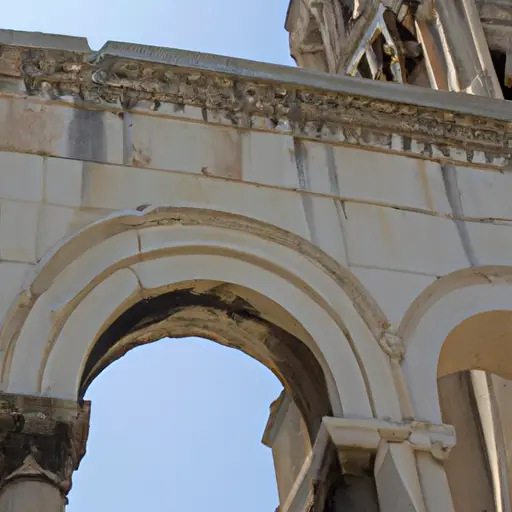Diocletian’s Mausoleum, Split : Interesting Facts, Information & Travel Guide

- By
- Aparna Patel
- |
- 24 Jun, 2023
- |

Welcome to the wonderful world of Diocletian’s Mausoleum, located in Split, Croatia! As one of the most fascinating points of interest in the entire region, there’s so much to love about this majestic structure. A historical monument that has stood the test of time, it is also an important part of modern day Split. In this blog post, we’ll dive into the exciting history and interesting facts about Diocletian’s Mausoleum, Split. We’ll also provide helpful travel tips and advice for making the most out of your visit to this remarkable landmark. So, grab your passport and get ready to explore the wonders of Diocletian’s Mausoleum!
Table of Contents
Interesting Facts About Diocletian’s Mausoleum, Split
1. Diocletian’s Mausoleum, also known as the Imperial Mausoleum was built for the burial of Emperor Diocletian in 305 AD.
2. The Mausoleum is located in the Palace of Diocletian in Split, Croatia.
3. It was designed and built by an unknown Roman architect and is the earliest example of a domed building.
4. The building is composed of several parts: the main dome, the four corner towers, and the two side chambers, and is constructed of white marble and granite.
5. Inside the Mausoleum is the sarcophagus of Emperor Diocletian, which is made from Carrara marble and decorated with exquisite mosaics.
6. The Mausoleum has been preserved because it was converted into a church in the 7th century.
7. The mausoleum still serves as an important landmark in the city of Split and is a popular tourist attraction.
8. It is now often used for concerts and other special events.
History & Information About Diocletian’s Mausoleum, Split
Diocletian’s Mausoleum is located in the city of Split, Croatia. It is situated near the central square of the city, known today as Pjaca. The mausoleum was built in the late 3rd century AD Roman emperor Diocletian. It was originally designed as the imperial palace of Diocletian, and it served him as a home until his death in 316 AD. Afterward, the structure was converted into a mausoleum over his remains.
The mausoleum is an impressive example of Roman engineering and architecture. It is a massive and imposing structure, built in the Roman style of the period and with the typical ornamental motifs of the classical Romans. The building is approximately 40 meters (130 feet) in height and 105 meters (345 feet) in length. The walls are made of stone and are more than two meters (six feet) thick.
Inside the mausoleum are a large central vaulted chamber and several smaller rooms. It is thought that Diocletian’s ashes were placed in this chamber after his death. The mausoleum also served as the final resting place of his wife and daughters. Despite its age and wear and tear, the structure has generally preserved its original design and form.
Throughout the years, Diocletian’s Mausoleum has been a site of cultural and architectural significance. It was used as a fortress during the Middle Ages and it has also served as the main symbol of Split. In 1979, it was listed as a UNESCO World Heritage Site, signifying its importance to the world’s cultural heritage.
- Church of St. Anastasia, Zadar : Interesting Facts, Information & Travel Guide
- Church of St. Francis, Dubrovnik : Interesting Facts, Information & Travel Guide
Travel Guide For Visiting Diocletian’s Mausoleum, Split
Croatia
This is a guide to help you in planning your trip when visiting Diocletian’s Mausoleum in Split, Croatia.
Getting There:
Split is easily accessible by plane, car, train, or by boat. The nearest major airport to Diocletian’s Mausoleum is Split (SPU) International Airport, about 20 minutes away. It is also possible to take a train from Zagreb, Croatia, which takes about 3 hours.
Accommodations:
There are many hotels and hostels available nearby Diocletian’s Mausoleum. Some of the closest include Splendid Hotel, Hotel Bastion, Luxe Hotel, and Park Poljud.
Attractions:
Diocletian’s Mausoleum is one of the oldest tourist attractions in Split, and one of the oldest preserved Roman structures in the world. The mausoleum was built in 300 AD and is the final resting place of Roman Emperor Diocletian. Other nearby attractions include the ruins of Diocletian’s Palace, the Split City Museum, and Fort Gripe.
Tours:
Several tour companies offer guided walking tours of Diocletian’s Mausoleum and the surrounding sites in Split. Popular tours include Split Explorers, Split You Tours, and Budget Split Tours.
Food:
There is a wide variety of restaurants in Split, including traditional Croatian cuisine like mussels, sardines, and octopus. Popular restaurants in the area include Apetit, Konoba Adriatica, and Bacarolino.
–
By following the guide above, you will be able to make the most of your time when visiting Diocletian’s Mausoleum in Split, Croatia. Enjoy your stay!
- Zadar, City: Facts, What to Eat, What To Buy & Tourist
- Cathedral of the Assumption, Dubrovnik : Interesting Facts, Information & Travel Guide
- Cathedral of St. Peter, Đakovo : Interesting Facts, Information & Travel Guide
Frequently Asked Questions About Diocletian’s Mausoleum, Split
Q: When was Diocletian’s Mausoleum built?
A: Diocletian’s Mausoleum was built in 305 AD.
Q: Where is Diocletian’s Mausoleum located?
A: Diocletian’s Mausoleum is located in the city of Split in Croatia.
Q: What materials were used to build Diocletian’s Mausoleum?
A: Diocletian’s Mausoleum was built from a combination of stone blocks and marble brought from nearby islands.
Q: Who commissioned Diocletian’s Mausoleum?
A: Diocletian’s Mausoleum was commissioned by Roman Emperor Diocletian.
Search Posts
Latest posts
-
4 Mar, 2024
Why would you wrap your luggage in plastic?
-
4 Mar, 2024
How to make dining alone less awkward?
-
5 Mar, 2024
Passing through airport security with autism
Popular posts
-
5 Mar, 2024
Why prohibit engine braking?